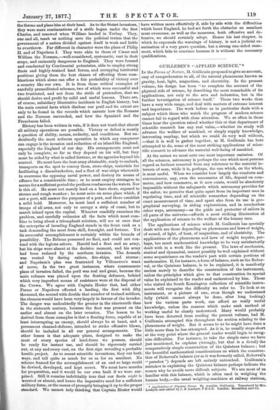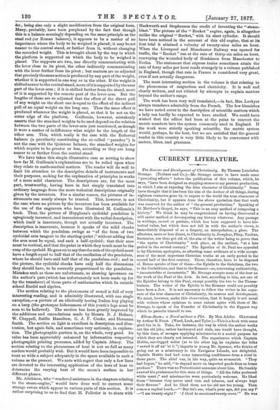GMT T WIN'S "APPLIED SCIENCE."* IN the Forces of Nature,
M. Guillemin proposed to give an account,. easy of comprehension to all, of the natural phenomena known as gravity, heat, light, magnetism, and electricity. In the present volume, his design has been "to complete the account of the physical side of science, by describing the most remarkable of its applications, not only to the arts and industries, but in the further investigation of science itself." These two works thus have a very wide range, and deal with matters of extreme interest and importance. The work before us in particular deals with a subject which those who watch the progress of modern science cannot fail to regard with close attention. We so often in these- times hear the question raised whether this or that department of scientific research has any real value,—whether its study wili advance the welfare of mankind, or simply supply knowledge,. interesting mayhap, but which we could do very well without,. —that it is well to gather together, as M. Guillemin has here attempted to do, some of the most striking applications of scien- tific research to advance the material well-being of mankind.
At the outset we must note one most important omission. Of all the sciences, astronomy is perhaps the one which most persons regard as farthest removed from any reference to the material in- terests of man, while it is, perhaps, the one which, on the whole,. is most useful. When we consider how largely the comforts and conveniences, nay, even the necessaries of life, depend on com- merce, and how commerce, as it now exists, would be absolutely impossible without the safeguards which astronomy provides for- the sailor, we perceive that quite apart from its important uses in regulating time, and all scientific researches depending on the- exact measurement of time, and apart also from its use in geo- graphical surveying, in aiding explorations, and in numberleas other ways, astronomy—as the guide and protector of sailors in all parts of the universe—affords a most striking illustration of the application of science to the welfare of the human race.
The applications of science which M. Guillemin has specially dealt with are those depending on phenomena and laws of weight, of sound, of light, of heat, of magnetism, and of electricity. The applications of the phenomena and laws of weight require, per- haps, too much mathematical knowledge to be very satisfactorily dealt with in a work like the present. The laws of mechanics,. statical and dynamical, cannot possibly be well explained without some acquaintance on the reader's part with certain portions of mathematics. If, for instance, a form of balance, such as the Rober- val, or the Quintenz balance, is to be explained, it is manifestly useless merely to describe the construction of the instrument, unless the principles which give to that construction its special value be explained to the reader and understood by him. Those who visited the South Kensington collection of scientific instru- ments will recognise the difficulty we refer to. To look at an instrument, or a picture of one, even though we understand fully (which cannot always be done, after long looking> how the various parts work, can afford no really useful knowledge, unless the reasons which make such method of working useful be clearly understood. Many would probably have been deterred from reading the present volume, had M. Guillemin attempted this throughout the section relating to the phenomena of weight. But it seems to us he might have done a little more than he has attempted. As it is, he usually stops short at the very point where the general reader would begin to recog- nise difficulties. For instance, to take the simple cases we have just mentioned, he explains (wrongly, but that is a detail) the comparatively simple construction of the Quintenz balance ; but the beautiful mathematical considerations on which the construc- tion of Roberval's balance (or as it was formerly called, Roberval's- " paradox ") depends are left entirely untouched. Guillemin's mistakes in explaining the Quintenz balance perhaps indicate the reason why he avoids more difficult subjects. We are most of us familiar with this balance, which is often used in weighing the human body,—the usual weighing-machines at railway stations, * Applications of Physical Forces. By Amddde Guillemin. Translated by Mrs.. I Lookyer, and edited by J. N.Lockyer, F.B.A.S. London: Macmillan and Co. &e., being also only a slight modification from the original form Many, probably, have been purplexed by the fact that though this is a balance seemingly depending on the same principle as the steel rod (or Roman balance), it appears to be a matter of no importance where the body to be weighed is placed; it may be set nearer to the central stand, or farther from it, without changing the recorded weight. This is brought about by the way in which the platform is supported on which the body to be weighed is placed. The supports are two, one directly communicating with the lever close to its pivot, the other indirectly communicating with the lever farther from its pivot ; but matters are so adjusted that precisely the same action is produced by any part of the weight, whether it is supported in one way or in the other. If the weight is shifted nearer to the central stand, more of it is supported by the near part of the lever-arm ; if it is shifted farther from the stand, more of it is supported by the remote part of the lever-arm. But the lengths of these are so adjusted that the effect of the direct pull of any weight on the short one is equal to the effect of the indirect pull of an equal weight on the long one. Thus the same effect is produced wherever the weight is placed, so that it be not on the outer edge of the platform. Guillemin, however, mistakenly asserts that the standard weights to be used depend on the relation between the two parts of the lever-arm just mentioned, as though it were a matter of indifference what might be the length of the other arm. This, which really is the case with the Roberval balance (a peculiarity constituting the so-called " paradox ") is not the case with the Quintenz balance, the standard weights for which require to be greater or less, according as they are hung nearer to or farther from the central stand.
We have taken this simple illustrative case as serving to show how far M. Guillemin's explanations are to be relied upon when they relate to mathematical matters. The reader will do well to limit his attention to the descriptive details of instruments and their purposes, seeking for the explanation of principles in works of a more solid character. The descriptions are, for the most part, trustworthy, having been in fact simply translated into ordinary language from the more technical descriptions originally given by the inventors. For a similar reason, the pictures of in- struments can nearly always be trusted. This, however, is not the case where no picture by the inventors has been available for the use of the engravers who have illustrated M. Guillemiu's book. Thus, the picture of Huyghens's cycloidal pendulum is egregiously incorrect, and inconsistent with the verbal description, which itself is inaccurate, though not actually incorrect. The description is inaccurate, because it speaks of the solid cheeks between which the pendulum swings as "of the form of two cycloidal arcs tangent to the starting-point ;" without adding that the arcs must be equal, and each a half-cycloid ; that their axes must be vertical, and that the point in which they touch must be the cusp of the cycloid. He goes on to say that the axis of the cycloid must have a length equal to half that of the oscillation of the pendulum, where he should have said half that of the pendulum-rod ; and in the picture, the cycloidal cheeks have only half the dimensions they should have, to be correctly proportioned to the pendulum. Mistakes such as these are unfortunate, as showing ignorance on the author's part (which has unfortunately not been made up for by the translator) of those parts of mathematics which lie outside school Euclid and algebra.
The section relating to the phenomena of sound is full of very interesting reading, and is admirably illustrated, with one single exception,—a picture of an idiotically leering Italian boy playing on a harp (the grotesque hideousness of this youth's legs must be seen to be believed). The section has been greatly improved by the additions and emendations made by Messrs. N. J. Holmes, W. Chappell, Bernie Hamilton, G. J. F. Cooke, and Hermann Smith. The section on light is excellent in description and illus- tration, but again fails, and sometimes very seriously, in explana- tion. The photographic portion is, on the whole, very good. Its value has been appreciably enhanced by information respecting photographic printing processes, added by Captain Abney. The section relating to the phenomena of heat is not so full as many readers would probably wish. But it would have been impossible to treat so wide a subject adequately in the space available in such a volume as the present. We note with regret that only a few lines are devoted to the interesting application of the laws of heat to determine the varying heat of the moon's surface in her different phases.
Mr. Aitchison, who " rendered assistance in the chapters relating to the steam-engine," would have done well to correct some strange errors which appear in various parts of this section. It is rather surprising to us to find that M. Pelletier is to share with
Hackworth and Stephenson the credit of inventing the "steam- blast." The picture of the " Rocket " engine, again, is altogether unlike the original "Rocket," with its slant cylinder. It should have been noticed in the account of this old engine, that at its first trial it attained a velocity of twenty-nine miles an hour. When the Liverpool and Manchester Railway was opened for traffic, the " Rocket " ran at the rate of thirty-six miles an hour, conveying the wounded body of Huskisson from Manchester to Eccles. The statement that express trains sometimes attain the rate of forty miles per hour reads strangely in a volume published in England, though that rate in France is considered very great, even if not actually dangerous.
The most interesting section in the volume is that relating to the phenomena of magnetism and electricity. It is well and clearly written, and not vitiated by attempts to explain matters beyond the author's range.
The work has been very well translated,—in fact, Mrs. Lockyer always translates admirably from the French. The few blemishes we have noted occur in the description of scientific matters which a lady can hardly be expected to have studied. We could have wished that the editor had been at the pains to convert the metric numbers into the system commonly used in England. If the work were strictly speaking scientific, the metric system would, perhaps, be the best, but we are satisfied that the general reader in this country is very little likely to be conversant with metres, litres, and grammes.



































 Previous page
Previous page